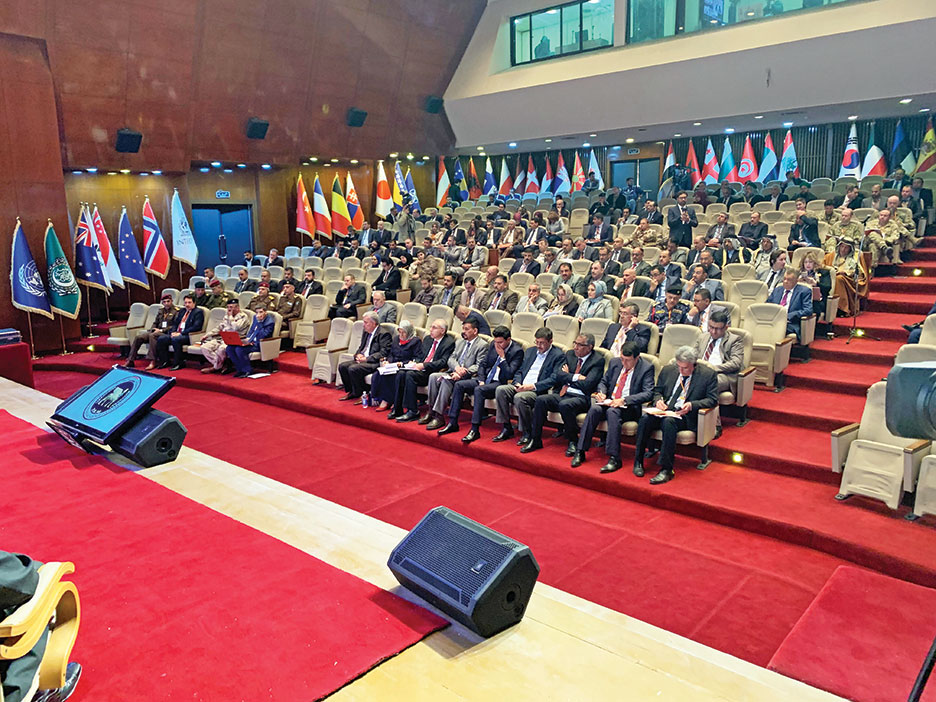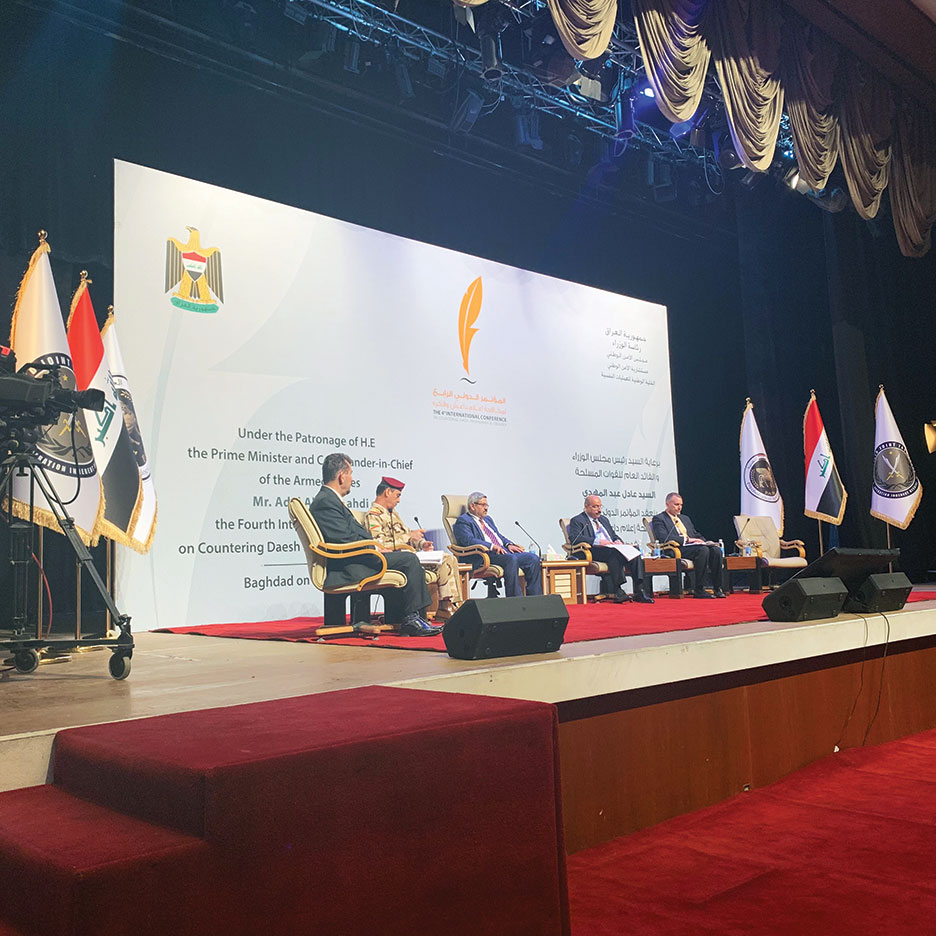The defeat of ISIS hasn’t ended the media campaign to spread hate and undermine society
It’s called “tablet jihad” — the use of computers or mobile phones to spread terrorist messaging. And according to Dr. Hafez Yasin Al-Heiti, a professor at Iraq’s Anbar University, ISIS members became masters of the craft.
The numbers were worrying: On Twitter alone, more than 300,000 accounts praised, promoted or otherwise supported the extremist organization between 2014 and 2017. On a competing platform called Telegram, ISIS had
3 million followers, more than half of them girls.
Daesh’s manipulation of the internet by posting shocking, violent and deceptive words and images has waned since coalition forces destroyed most of the group’s hideouts in northern Iraq and Syria. But presenters at the fourth International Conference to Combat ISIS Propaganda and Ideology, held February 20-22, 2019, in Baghdad, warned that terrorists remain a threat on social media.

“ISIS’ media is still a source of concern. It persists in spreading hatred, violence, exclusion, and declaring others as infidels. This media is dangerous because of its role in destroying hearts and minds,” Issam Abbas Amin of Iraq’s Security and Intelligence Directorate told the multinational gathering of military officers, government officials and academics.
Held under the auspices of Iraqi Prime Minister Dr. Adil Abdul-Mahdi, the conference consisted mostly of speeches by Iraqi experts in the field of counterterrorism and media messaging. Maj. Gen. Ahmed Hassan Hussein of the Iraqi Ministry of the Interior noted that ISIS enlists professional hackers to mask its digital footprint on the internet, making it difficult to monitor them. Once its messaging is up and running, ISIS uses sophisticated psychological techniques to manipulate its mostly young target audience.
Dr. Al-Heiti broke that messaging into three categories, depending on the audience’s level of support
or opposition to ISIS:
Rhetoric targeting sympathizers and supporters: The organization set up local radio stations and loudspeakers in moving cars to broadcast its programs to the population via the Al-Bayan radio station, and ISIS used social media to communicate to sympathizers in far-flung parts of the world. The programs focused on opening schools, cleaning roads, regulating traffic and prayer in public places to make people believe the terrorists were bringing order. It also attracted fighters and lured people deceived by this false image to migrate to the “caliphate’s” territory.
Rhetoric targeting the undecided: ISIS focused on portraying its followers as devout, pious and paragons of morality. They made videos of people in the field talking about their experience to win over an audience. To try to earn people’s affections, ISIS portrayed its fighters as strong and determined, giving them names and sobriquets of the companions of the Prophet. This rhetoric was spread through its publications and broadcasts and on social media pages.
Rhetoric targeting the organization’s enemies: This was the most popular message, as ISIS focused on retribution, intimidation, and making an example of its opponents or anyone whose loyalty was in doubt. ISIS devised methods previously unknown to humanity to try to sow terror in their opponents’ hearts. ISIS used modern videography techniques and sound effects to produce high-definition, professional videos, embedding their media products in the public consciousness.

“ISIS focused on professional photography of battles and creating attractive images to portray daily life in the Islamic State’s provinces,” Dr. Al-Heiti said. “They also spread ideas to sympathizers and enticed them to martyrdom as a route to paradise. These materials are available in Arabic, English, French, Russian, Chinese and other languages.”
Issam Amin recounted how ISIS created a media arm called Al-Furqan to produce video, posters, leaflets, and official audio and written statements. That media machine grew as ISIS seized territory and demanded more video and audio propaganda. The most prominent media foundations were called Al-Itisam and Ajnad. In 2014, terrorists created the Al-Hayat Media Center to produce material in foreign languages directed mostly at the West.
It is worth mentioning that these media operations enjoyed important advantages, such as experienced professional staff, modern technical capabilities, a high degree of secrecy and significant financial support. They supervised the publication of 11 video, print and electronic magazines. Nearly 2,000 products were produced and propagated from 2015 to 2017.
Although media production collapsed in 2018 as ISIS was squeezed into ever smaller territory in Syria, the propaganda machine survives with the help of unofficial institutions and advocates that promote ISIS messaging on social media outlets such as Telegram.
It will require a considerable international effort to eradicate ISIS’ large media archive and shut down websites that disseminate messages of hatred, violence and murder, Dr. Amin said.
Another conference speaker, Dr. Marleen Hormiz of Al-Israa University College, analyzed the terrorists’ media output and noticed ISIS was sophisticated enough to use as many as 18 psychological warfare techniques. Videos were professionally produced with an attention to setting, color, graphics and camera movement. Sound effects such as religious chants and clanging swords heightened the effect.
“Visual content is one of the main pillars on which the use of Twitter in ISIS’ electronic, psychological warfare is based,” Dr. Hormuz said. “Among the organization’s members or supporters are experts in psychological warfare.”
The coalition wasn’t without its own psychological warfare strategy. Iraqi Staff Maj. Gen. Khaled Al-Tamimi of the Joint Forces Command described the high-level coordination required to win the battles against ISIS.
“From the first day of the liberation battles, the Joint Forces Command formed a planning team comprising the best field commanders, in addition to incorporating information operations and psychological warfare experts in the plans,” the general said. “This indicates that the war against ISIS is based on information operations, exposing the enemy’s lies and winning over the population.”
The initial departure of Iraqi forces from Mosul at the beginning of the crisis fed enemy propaganda and weakened morale among government troops. But ISIS soon lost the crucial battle to capture the population’s loyalty, Gen. Al-Tamimi said.
ISIS gangs acted recklessly without regard for the lives of innocent people. They began to divide the population into groups, scrawling the letter “N” on Christian houses and “R” on Shia houses. Sunnis were sorted in descending order of obedience to ISIS: loyalists, apostates and agents. This discrimination outraged the tolerant people of Mosul.
“Our liberation forces benefited from this situation and invested considerable time in reaching out to the population by dropping leaflets and sending SMS [short message service, or text messages] and radio messages, so that civilians would be ready to cooperate with their armed forces and contribute important intelligence about enemy positions,” the general said.
Dr. Mahmoud Azzou Hamdo of Mosul University recalled how ISIS produced propaganda suggesting the city was happy about the terrorist occupation. The reality was the opposite. For example, to make phony videos portraying the population’s gratitude to ISIS, people were forcibly herded to Friday prayers to sing the terrorists’ praises.
Dr. Hamdo warned that ISIS’ media manipulation still has lingering effects in Iraq.
“ISIS left a formidable legacy of what we call ‘ISIS-ification,’ which is still practiced in all segments of society, with false slander, exclusion and discrimination against certain people or groups of society,” Dr. Hamdo said. “Nineveh is religiously and ethnically diverse, and when any group is excluded or rejected, it reflects messages of hate and establishes a dangerous environment favorable to ISIS.”
Although the destruction of ISIS as a political and military force has weakened the group’s media campaign, no speakers at the conference urged complacency on the part of counterterrorism forces.
Dr. Laith Kubbah, advisor to Iraqi Prime Minister Abdul-Mahdi, said that ISIS still has the ability to recruit and maintain sleeper cells that can expand in the country and the region.
“Yes, the young generation rejects them because of their crimes,” Dr. Kubbah said. “But we are worried about young people in marginalized, remote areas. So, we must be on guard against the return of ISIS, and young people must be immunized against the danger of extremist rhetoric.”
Examining ISIS Crimes: Bridging a Cultural Divide
ISSAM ABBAS AMIN, IRAQI SECURITY AND INTELLIGENCE DIRECTORATE
Once again, as with every time Iraqi and Western minds meet, the effects of cultural differences are clear in approaches and topics (despite globalization). As a real world example of this, I will address the paper that French journalist Michel Scott presented at the fourth International Conference to Combat ISIS Propaganda and Ideology, held February 20-22, 2019, in Baghdad. In my opinion, Scott’s paper did not receive enough attention from the audience: first, because of the translation, and second, because of cultural differences.
With 25 years of experience accumulated from covering wars around the world, Scott has the legitimacy to discuss the issues of war, terrorism and extremism. He understands that the mission of journalism is no longer just to report news of events but also to analyze news to teach people what is behind major events. Any talk of war will inevitably raise the matter of global, ethical and human rights standards related to justice and the rules of war, so the media’s role can improve things or make them worse, especially with regard to social cohesion, depending on how they are promoted and the nature of the discourse and narrative.
This sensitive and necessary task becomes more complex when extremism is part of people’s intellectual environment. The French today are shocked not only that hundreds of their compatriots joined ISIS, but also that those French-speaking terrorists employed more heinous and radical discourse than others. This surprise must represent a major flaw in news coverage, and members of the media are largely responsible because of the nature of their approach to terrorist incidents. Their most considerable mistakes were:
- Focusing on incidents in the moment, without explaining their long-term effects.
- Focusing on certain parts of the news and omitting other elements of the truth.
In the context of his presentation, Scott tried to highlight and draw attention to a complex problem related to the families (women and children) of foreign ISIS fighters, specifically French nationals, by posing a series of questions, the most important of which were:
- Do they deserve to return to their home countries?
- Do they have any rights?
- Are they still French?
- How should they be classified?
Through a simple analysis of the nature of these and other questions, we noticed that the concern is not so much about what these women have done but what rights they still have.
This is a different type of approach, one that may be understandable to a French person or a Westerner imbued with the values of freedom and human rights, but one that is difficult for those who have suffered enormously, over many years, from the crimes of ISIS.
Scott calls for historic trials, like the ones at Nuremberg after World War II, to rule on a case that, in his view, requires common sense and a further exploration of historical facts that would ultimately explain much of the brutality that characterizes ISIS.
The crux of the matter is not to simply label something evil, but to expose its true essence. This is also a different approach, one rarely used in an environment that often avoids speaking the truth.
To achieve justice, Scott calls for avoiding ready-made descriptions and generic talk about extremism, terrorism and ideology. He says that what is needed today is a new kind of thinking capable of avoiding confusion to examine the causes of the aberrant ideology that produced ISIS and to encourage a kind of intellectual evolution in the face of terrorism.
Our self-interest and rationality require that we work to disentangle terrorism and Islam and reduce the degree of hatred for the actual religion, always remembering that most of the victims of ISIS terrorism were Muslims, and it did not matter at the time whether they were Shias, Sunnis or Kurds.

